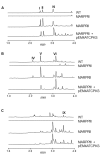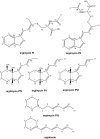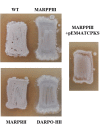Identification by Genome Mining of a Type I Polyketide Gene Cluster from Streptomyces argillaceus Involved in the Biosynthesis of Pyridine and Piperidine Alkaloids Argimycins P
- PMID: 28239372
- PMCID: PMC5300972
- DOI: 10.3389/fmicb.2017.00194
Identification by Genome Mining of a Type I Polyketide Gene Cluster from Streptomyces argillaceus Involved in the Biosynthesis of Pyridine and Piperidine Alkaloids Argimycins P
Abstract
Genome mining of the mithramycin producer Streptomyces argillaceus ATCC 12956 revealed 31 gene clusters for the biosynthesis of secondary metabolites, and allowed to predict the encoded products for 11 of these clusters. Cluster 18 (renamed cluster arp) corresponded to a type I polyketide gene cluster related to the previously described coelimycin P1 and streptazone gene clusters. The arp cluster consists of fourteen genes, including genes coding for putative regulatory proteins (a SARP-like transcriptional activator and a TetR-like transcriptional repressor), genes coding for structural proteins (three PKSs, one aminotransferase, two dehydrogenases, two cyclases, one imine reductase, a type II thioesterase, and a flavin reductase), and one gene coding for a hypothetical protein. Identification of encoded compounds by this cluster was achieved by combining several strategies: (i) inactivation of the type I PKS gene arpPIII; (ii) inactivation of the putative TetR-transcriptional repressor arpRII; (iii) cultivation of strains in different production media; and (iv) using engineered strains with higher intracellular concentration of malonyl-CoA. This has allowed identifying six new alkaloid compounds named argimycins P, which were purified and structurally characterized by mass spectrometry and nuclear magnetic resonance spectroscopy. Some argimycins P showed a piperidine ring with a polyene side chain (argimycin PIX); others contain also a fused five-membered ring (argimycins PIV-PVI). Argimycins PI-PII showed a pyridine ring instead, and an additional N-acetylcysteinyl moiety. These compounds seem to play a negative role in growth and colony differentiation in S. argillaceus, and some of them show weak antibiotic activity. A pathway for the biosynthesis of argimycins P is proposed, based on the analysis of proposed enzyme functions and on the structure of compounds encoded by the arp cluster.
Keywords: Streptomyces; alkaloid; cryptic; growth; piperidine; pyridine; thioester reductase; type I polyketide synthase.
Figures







Similar articles
-
New Insights into the Biosynthesis Pathway of Polyketide Alkaloid Argimycins P in Streptomyces argillaceus.Front Microbiol. 2018 Feb 16;9:252. doi: 10.3389/fmicb.2018.00252. eCollection 2018. Front Microbiol. 2018. PMID: 29503641 Free PMC article.
-
Combinatorial biosynthesis yields novel hybrid argimycin P alkaloids with diverse scaffolds in Streptomyces argillaceus.Microb Biotechnol. 2022 Dec;15(12):2905-2916. doi: 10.1111/1751-7915.14167. Epub 2022 Nov 8. Microb Biotechnol. 2022. PMID: 36346129 Free PMC article.
-
Transcriptional regulation of mithramycin biosynthesis in Streptomyces argillaceus: dual role as activator and repressor of the PadR-like regulator MtrY.Microbiology (Reading). 2015 Feb;161(Pt 2):272-284. doi: 10.1099/mic.0.080895-0. Microbiology (Reading). 2015. PMID: 25416691
-
Biosynthesis, regulation, and engineering of a linear polyketide tautomycetin: a novel immunosuppressant in Streptomyces sp. CK4412.J Ind Microbiol Biotechnol. 2017 May;44(4-5):555-561. doi: 10.1007/s10295-016-1847-2. Epub 2016 Oct 12. J Ind Microbiol Biotechnol. 2017. PMID: 27734184 Review.
-
Regulation of Geldanamycin Biosynthesis by Cluster-Situated Transcription Factors and the Master Regulator PhoP.Antibiotics (Basel). 2019 Jun 30;8(3):87. doi: 10.3390/antibiotics8030087. Antibiotics (Basel). 2019. PMID: 31262015 Free PMC article. Review.
Cited by
-
Natural transaminase fusions for biocatalysis.RSC Adv. 2024 Jan 31;14(6):4264-4273. doi: 10.1039/d3ra07081f. eCollection 2024 Jan 23. RSC Adv. 2024. PMID: 38298934 Free PMC article.
-
PCR-based Screening Approach: A Rapid Method to Detect the Biosynthetic Potential of Antimicrobials in Actinobacterial Strains.Pol J Microbiol. 2020;69(2):1-11. doi: 10.33073/pjm-2020-016. Pol J Microbiol. 2020. PMID: 32396716 Free PMC article.
-
Genome Analysis of Streptomyces nojiriensis JCM 3382 and Distribution of Gene Clusters for Three Antibiotics and an Azasugar across the Genus Streptomyces.Microorganisms. 2021 Aug 25;9(9):1802. doi: 10.3390/microorganisms9091802. Microorganisms. 2021. PMID: 34576698 Free PMC article.
-
Novel Alkaloids from Marine Actinobacteria: Discovery and Characterization.Mar Drugs. 2021 Dec 22;20(1):6. doi: 10.3390/md20010006. Mar Drugs. 2021. PMID: 35049861 Free PMC article. Review.
-
Screening and characterization of a diverse panel of metagenomic imine reductases for biocatalytic reductive amination.Nat Chem. 2021 Feb;13(2):140-148. doi: 10.1038/s41557-020-00606-w. Epub 2020 Dec 30. Nat Chem. 2021. PMID: 33380742 Free PMC article.
References
-
- Aguirrezabalaga I., Olano C., Allende N., Rodriguez L., Braña A. F., Méndez C., et al. (2000). Identification and expression of genes involved in biosynthesis of L-oleandrose and its intermediate L-olivose in the oleandomycin producer Streptomyces antibioticus. Antimicrob. Agents. Chemother. 44 1266–1275. 10.1128/AAC.44.5.1266-1275.2000 - DOI - PMC - PubMed
-
- Aleku G. A., Man H., France S. P., Leipold F., Hussain S., Toca-Gonzalez L., et al. (2016). Stereoselectivity and structural characterization of an imine reductase (IRED) from Amycolatopsis orientalis. ACS Catal. 6 3880–3889. 10.1021/acscatal.6b00782 - DOI
LinkOut - more resources
Full Text Sources
Other Literature Sources
Molecular Biology Databases
Research Materials
Miscellaneous

